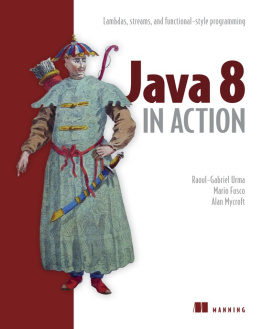Urma - Manning Java 8 in Action, Lambdas Streams and Functional-Style Programming
Here you can read online Urma - Manning Java 8 in Action, Lambdas Streams and Functional-Style Programming full text of the book (entire story) in english for free. Download pdf and epub, get meaning, cover and reviews about this ebook. year: 2015;2019, genre: Computer. Description of the work, (preface) as well as reviews are available. Best literature library LitArk.com created for fans of good reading and offers a wide selection of genres:
Romance novel
Science fiction
Adventure
Detective
Science
History
Home and family
Prose
Art
Politics
Computer
Non-fiction
Religion
Business
Children
Humor
Choose a favorite category and find really read worthwhile books. Enjoy immersion in the world of imagination, feel the emotions of the characters or learn something new for yourself, make an fascinating discovery.
- Book:Manning Java 8 in Action, Lambdas Streams and Functional-Style Programming
- Author:
- Genre:
- Year:2015;2019
- Rating:4 / 5
- Favourites:Add to favourites
- Your mark:
- 80
- 1
- 2
- 3
- 4
- 5
Manning Java 8 in Action, Lambdas Streams and Functional-Style Programming: summary, description and annotation
We offer to read an annotation, description, summary or preface (depends on what the author of the book "Manning Java 8 in Action, Lambdas Streams and Functional-Style Programming" wrote himself). If you haven't found the necessary information about the book — write in the comments, we will try to find it.
Urma: author's other books
Who wrote Manning Java 8 in Action, Lambdas Streams and Functional-Style Programming? Find out the surname, the name of the author of the book and a list of all author's works by series.
Manning Java 8 in Action, Lambdas Streams and Functional-Style Programming — read online for free the complete book (whole text) full work
Below is the text of the book, divided by pages. System saving the place of the last page read, allows you to conveniently read the book "Manning Java 8 in Action, Lambdas Streams and Functional-Style Programming" online for free, without having to search again every time where you left off. Put a bookmark, and you can go to the page where you finished reading at any time.
Font size:
Interval:
Bookmark:

For online information and ordering of this and other Manning books, please visit www.manning.com. The publisher offers discounts on this book when ordered in quantity. For more information, please contact
Special Sales Department Manning Publications Co. 20 Baldwin Road PO Box 761 Shelter Island, NY 11964 Email: orders@manning.com2015 by Manning Publications Co. All rights reserved.
No part of this publication may be reproduced, stored in a retrieval system, or transmitted, in any form or by means electronic, mechanical, photocopying, or otherwise, without prior written permission of the publisher.
Many of the designations used by manufacturers and sellers to distinguish their products are claimed as trademarks. Where those designations appear in the book, and Manning Publications was aware of a trademark claim, the designations have been printed in initial caps or all caps.
 Recognizing the importance of preserving what has been written, it is Mannings policy to have the books we publish printed on acid-free paper, and we exert our best efforts to that end. Recognizing also our responsibility to conserve the resources of our planet, Manning books are printed on paper that is at least 15 percent recycled and processed without the use of elemental chlorine.
Recognizing the importance of preserving what has been written, it is Mannings policy to have the books we publish printed on acid-free paper, and we exert our best efforts to that end. Recognizing also our responsibility to conserve the resources of our planet, Manning books are printed on paper that is at least 15 percent recycled and processed without the use of elemental chlorine.
 | Manning Publications Co.20 Baldwin RoadPO Box 761Shelter Island, NY 11964 | Development editor: Susan ConantTechnical development editor Al SchererCopyeditor: Linda RecktenwaldProofreader: Katie TennantTypesetter: Dennis DalinnikCover designer: Maria Tudor |
ISBN: 9781617291999
Printed in the United States of America
1 2 3 4 5 6 7 8 9 10 EBM 19 18 17 16 15 14
To our parents
Back in 1998 when I was eight years old, I picked up my first book on computingon JavaScript and HTML. Little did I know that opening that book would transform my life by exposing me to programming languages and the amazing things I could do with them. I was hooked. Every so often I still find a new programming language feature that revives this excitement because it enables me to write clearer, more concise code in half the time. I hope that the new ideas in Java 8, incorporated from functional programming and explored in this book, inspire you in the same way.
So, you may wonder, how did this book come about?
Well, back in 2011, Brian Goetz (the Java Language Architect at Oracle) was sharing various proposals to add lambda expressions to Java, with the aim of getting the community involved. These rekindled my excitement, and I started to evangelize the ideas, organizing Java 8 workshops at various developer conferences and giving lectures to students at the University of Cambridge.
By April 2013, word had spread, and our publisher at Manning emailed asking whether I was interested in writing a book about lambdas in Java 8. At the time I was a humble second-year PhD candidate, and that seemed to be a bad idea because it would interfere with my thesis submission schedule. On the other hand, carpe diem; I thought writing a short book shouldnt be too much work, right? (It was only later that I realized I was utterly wrong!) So I sought advice from my PhD supervisor, Professor Alan Mycroft, who, it turned out, was ready to support me in this adventure (even offering to help in such non-PhD workIm forever in his debt). A few days later we met fellow Java 8 evangelist Mario Fusco, who had vast professional experience and had become well known for his talks on functional programming at major developer conferences.
We quickly realized that by combining our energy and diverse backgrounds we could deliver, not just a short book on Java 8 lambdas, but instead a book that, we hope, the Java community will still be reading in five or ten years. We had a unique opportunity to discuss in depth many topics that will benefit Java programmers and open doors to a new universe of ideas: functional programming.
NowJuly 2014, 15 months later, after many long nights, endless edits, and an unforgettable experienceyou have our work in your hands and we hope you will enjoy it!
R AOUL -G ABRIEL U RMA
U NIVERSITY OF C AMBRIDGE
This book would not have been possible without the support of many amazing people:
- Personal friends and people who provided valuable reviews and suggestions on a volunteer basis: Richard Walker, Jan Saganowski, Brian Goetz, Stuart Marks, Cem Redif, Paul Sandoz, Stephen Colebourne, igo Mediavilla, Allahbaksh Asadullah, Tomasz Nurkiewicz, and Michael Mller
- Our Manning Early Access Program (MEAP) readers who posted comments in the Author Online forum
- The reviewers from the development process who provided helpful feedback: Antonio Magnaghi, Brent Stains, Franziska Meyer, Furkan Kamachi, Jason Lee, Jrn Dinkla, Lochana Menikarachchi, Mayur Patil, Nikolaos Kaintantzis, Simone Bordet, Steve Rogers, Will Hayworth, and William Wheeler
- Susan Conant, our development editor at Manning, who was very patient in answering all our questions and concerns, provided detailed feedback for each of our draft chapters, and supported us in all possible ways
- Ivan Todorovi and Jean-Franois Morin, who provided a thorough technical proofread of the manuscript shortly before it went to production; and Al Scherer, who provided technical expertise during development
R AOUL -G ABRIEL U RMA
First and foremost, Id like to thank my parents for their endless love and support in my life. This little dream of writing a book has now come true! Next, I would like to express my eternal gratitude to Alan Mycroft, my PhD supervisor and coauthor, for his trust and support. Id also like to thank my coauthor Mario Fusco for sharing this fun journey. Finally, Id like to thank friends who have provided mentorship, useful advice, and encouragement in my life: Sophia Drossopoulou, Aidan Roche, Warris Bokhari, Alex Buckley, Martijn Verburg, Tomas Petricek, and Tian Zhao. You guys rock!
M ARIO F USCO
Id like to especially thank my wife, Marilena, whose boundless patience allowed me to stay focused on the book, and our daughter, Sofia, because the infinite chaos she can produce allowed me to get creatively distracted from the book. As youll discover reading the book, Sofia also taught us, like only a two-year-old baby girl can, the difference between internal and external iteration. Id like to also thank Raoul-Gabriel Urma and Alan Mycroft, with whom I shared the (big) joys and the (small) pains of this writing experience.
A LAN M YCROFT
Id like to thank my wife, Hilary, and the rest of my family for enduring the many hours that just a bit more work to do on the book consumed. I also thank my colleagues and students over the years for teaching me how to teach, Mario and Raoul for being such efficient coauthors, and particularly Raoul for his skill at being so pleasantly demanding when requiring the next bit of text by Friday.
Put simply, the new features in Java 8 are the biggest change to Java in the 18 years since Java 1.0 was released. Nothing has been taken away, so all your existing Java code continues to workbut the new features provide powerful new idioms and design patterns to help you write clearer, more concise code. At first you might think (as with all new features), Why are they changing my language again? But then, after a bit of practice, comes the revelation that youve just used the features to write shorter, clearer code in half the time you expectedand you realize you could never go back to old Java again.
Font size:
Interval:
Bookmark:
Similar books «Manning Java 8 in Action, Lambdas Streams and Functional-Style Programming»
Look at similar books to Manning Java 8 in Action, Lambdas Streams and Functional-Style Programming. We have selected literature similar in name and meaning in the hope of providing readers with more options to find new, interesting, not yet read works.
Discussion, reviews of the book Manning Java 8 in Action, Lambdas Streams and Functional-Style Programming and just readers' own opinions. Leave your comments, write what you think about the work, its meaning or the main characters. Specify what exactly you liked and what you didn't like, and why you think so.




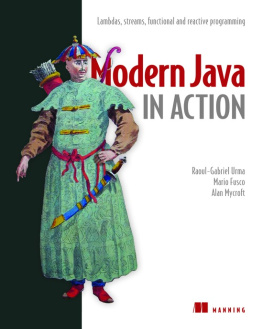

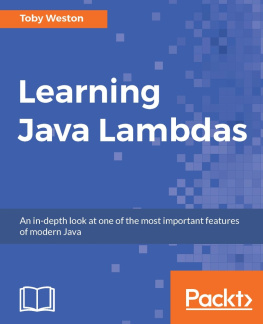
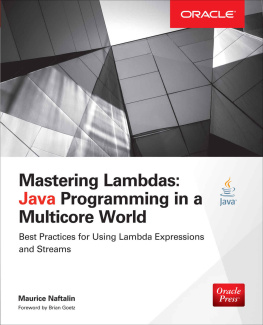
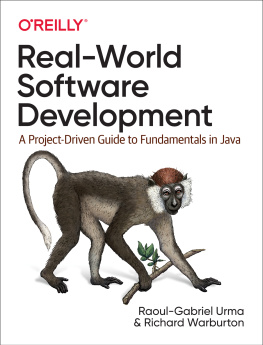
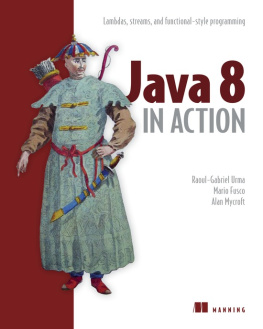
![Pierre-Yves Saumont [Pierre-Yves Saumont] - Functional Programming in Java: How functional techniques improve your Java programs](/uploads/posts/book/119337/thumbs/pierre-yves-saumont-pierre-yves-saumont.jpg)

